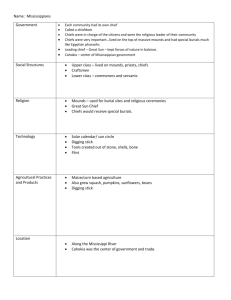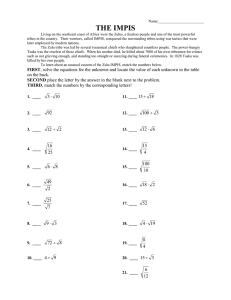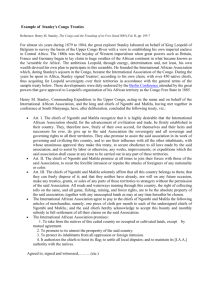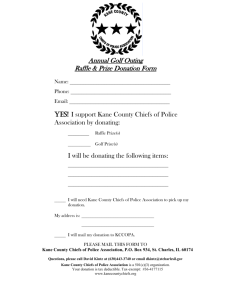Consolidating Democracy and Building the Nation: Chiefs in South Africa
advertisement
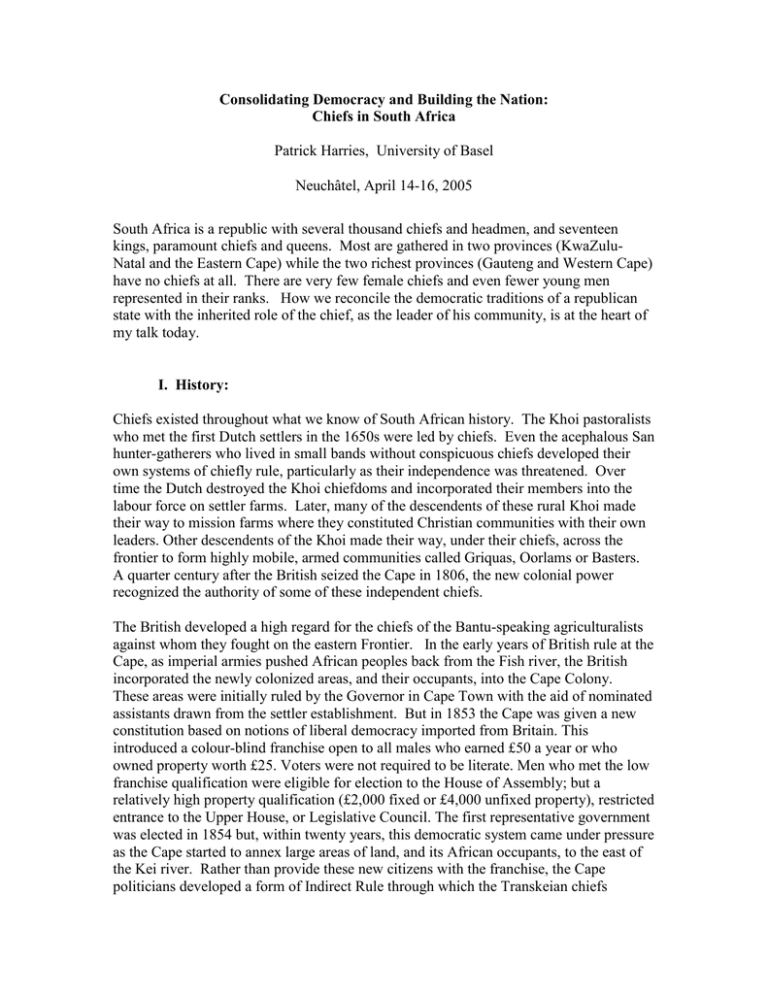
Consolidating Democracy and Building the Nation: Chiefs in South Africa Patrick Harries, University of Basel Neuchâtel, April 14-16, 2005 South Africa is a republic with several thousand chiefs and headmen, and seventeen kings, paramount chiefs and queens. Most are gathered in two provinces (KwaZuluNatal and the Eastern Cape) while the two richest provinces (Gauteng and Western Cape) have no chiefs at all. There are very few female chiefs and even fewer young men represented in their ranks. How we reconcile the democratic traditions of a republican state with the inherited role of the chief, as the leader of his community, is at the heart of my talk today. I. History: Chiefs existed throughout what we know of South African history. The Khoi pastoralists who met the first Dutch settlers in the 1650s were led by chiefs. Even the acephalous San hunter-gatherers who lived in small bands without conspicuous chiefs developed their own systems of chiefly rule, particularly as their independence was threatened. Over time the Dutch destroyed the Khoi chiefdoms and incorporated their members into the labour force on settler farms. Later, many of the descendents of these rural Khoi made their way to mission farms where they constituted Christian communities with their own leaders. Other descendents of the Khoi made their way, under their chiefs, across the frontier to form highly mobile, armed communities called Griquas, Oorlams or Basters. A quarter century after the British seized the Cape in 1806, the new colonial power recognized the authority of some of these independent chiefs. The British developed a high regard for the chiefs of the Bantu-speaking agriculturalists against whom they fought on the eastern Frontier. In the early years of British rule at the Cape, as imperial armies pushed African peoples back from the Fish river, the British incorporated the newly colonized areas, and their occupants, into the Cape Colony. These areas were initially ruled by the Governor in Cape Town with the aid of nominated assistants drawn from the settler establishment. But in 1853 the Cape was given a new constitution based on notions of liberal democracy imported from Britain. This introduced a colour-blind franchise open to all males who earned £50 a year or who owned property worth £25. Voters were not required to be literate. Men who met the low franchise qualification were eligible for election to the House of Assembly; but a relatively high property qualification (£2,000 fixed or £4,000 unfixed property), restricted entrance to the Upper House, or Legislative Council. The first representative government was elected in 1854 but, within twenty years, this democratic system came under pressure as the Cape started to annex large areas of land, and its African occupants, to the east of the Kei river. Rather than provide these new citizens with the franchise, the Cape politicians developed a form of Indirect Rule through which the Transkeian chiefs continued to govern their own people – although with the aid of government magistrates. At the beginning of the twentieth century a parliament for chiefs, or Bunga, was erected in the Transkeian capital of Umtata. Chiefs sat alongside magistrates in the Bunga where they representated their communities and, in this building, discussed and voted on issues of interest to their communities. In the colony of Natal, established by the British in 1843, a different form of Indirect Rule emerged. In this area, a form of segregation was initiated at the onset of British rule as the land was divided between European settlers and African chiefs who ruled in areas “reserved” for African occupation, as well as on “Crown land” (that still had to be sold) or on large mission farms or “reserves”. This “Shepstonian system” (named after its inventor) acted as a model of Indirect Rule for other parts of the British empire, especially at the Cape. It turned the chief into a paid government official who maintained law and order and who collected taxes for the government. Some historians argue that the roots of segregation are to be found in the Shepstonian system as, although the chiefs continued to exercise a limited authority over their people, almost all Africans were prohibited from participating in the electoral politics of the colony. In the interior, settlers escaping from British rule at the Cape formed two, independent republics during the late 1830s-40s. These descendents of the early Dutch settlers initially gathered in the interior in their own political communities under their own chiefs. In the early 1850s these communities coalesced to form the Orange Free State and the South African Republic that were duly recognized by the British as independent territories. Independent chiefs ruled many areas claimed by these impoverished republics well into the 1880s. The discovery of gold transformed the Transvaal and the last of the independent chiefs was finally conquered in 1898 and he, like the chiefs to the south, was incorporated into a rural “location” or reserve. The chiefs in these republics could advise the local representatives of the “Native Affairs” department – but only on an informal basis. Africans in these “trekker” republics had no political representation. The Union of South Africa, established in 1910, brought together the Cape, Natal, Transvaal and Orange Free State but left “the native question” unresolved. Africans who qualified to vote in the Cape continued to do so while those in the Transvaal and OFS were excluded from electoral politics – as were almost all African in Natal. Even in the Cape, the qualifications for the franchise were constantly raised in such a way as to exclude Africans; and the Bunga provided the main outlet for African political ambitions. During the 1920s, segregation provided the Union with a comprehensive answer to the “native question”. This caused Africans in the Cape to be removed from the common voters’ role in 1936. Africans throughout South Africa were then allowed to vote for white members of parliament who would represent their interests. In this way, blacks were excluded from sitting in the national parliament; and their voting power was effectively segregated to a handful of white parliamentary representatives. In the meantime, segregation reinforced the role of the chiefs who were regarded by most white politicians to be the “real” representatives of the African people. As early as 1913, the Natives’ Land Act prohibited whites from buying land in those areas of South Africa reserved for African occupation. While Africans were also prohibited, under the law, from buying land in “white” areas, the extent of the reserves (i.e. those areas ruled by chiefs) was increased by the Act. In the 1920s various laws were passed in an attempt to stop the disintegration of the chiefs’ powers; for as South Africa became an industrial country, large numbers of men (and increasingly women) had started to escape the control of the chiefs. The new laws recognized the role of the chiefs as civil servants, provided them with a formal income, and entrenched tribal law and custom. Under this legislation, the government eventually recognized various “Paramount” chiefs – most notably the Zulu chief (whose ancestors had never governed the Zulu-speaking people living south of the Tugela river in the British colony of Natal). Under the Apartheid system established in 1948, segregationist politicians saw the chiefs and the reserves as a solution to a “native question” that had reemerged as “detribalized” Africans increasingly demanded direct representation in the electoral politics of the nation. In the 1950s the various reserves were enlarged and incorporated into “Territorial Authorities” that came to be known as ethnic “homelands” or “Bantustans”. In these areas chiefs ruled “Tribal Authorities” and were nominated to fill most of the seats in the legislative assemblies. In the Transkei this meant that the Bunga became the parliament of the Transkeian homeland that, in 1963, became an “independent” state. In reality, most homelands remained almost entirely dependent for their finances on the central government in Pretoria (which was dependent on the whites-only parliament in Cape Town). However in at least one homeland, the Tswana state of “Bophuthatswana”, the local government was able to acquire sufficient revenue (in this case from platinum mining) to establish an independent economic infrastructure. In KwaZulu, chief Mangosotho Buthelezi originally came to power with the support of the exiled African National Congress. But by the late 1970s he had developed a mass-based political following in KwaZulu that threatened the dominance of the ANC in the area. Elsewhere, two homelands (besides the Transkei and Bophuthatswana) took independence and, in the 1980s, were seized by military dictators (Venda and Ciskei). Chiefs were not simple collaborators in the running of the homelands. In September 1987 a group of 38 chiefs met to form a Congress of Traditional Leaders of South Africa that operated independently of Inkatha. Contralesa served the interests of chiefs but, unlike Inkatha, called for the dismantling of the Bantustan system. However in most parts of South Africa chiefs supported apartheid structures and prevented the ANC from infiltrating into their territory. In the KwaZulu-Natal area the competition between the ANC and the Inkatha Freedom Party of chief Buthelezi led to open fighting in the mid1980s. When the transfer of power was initiated in South Africa in 1990, this fighting spread to other parts of the country and, as the country approached an electoral solution to its problems, a low-intensity civil war broke out. In the end, the homeland leaders constituted the last defenders of the apartheid system (on which they were dependent for their political survival). While some homelands openly supported the ANC in the early 1990s (Transkei and Venda), others prepared to do battle. When the ANC tried to seize control of the independent Ciskei homeland in 1992, the local military dictator gave orders to fire on demonstrators – of whom over thirty were killed. In similar circumstances in Bophuthatswana, chief Mongope called on armed right-wing opponents of majority rule for support. This brought South Africa close to the edge of full-scale civil war in early 1994. Even when Bophuthatswana eventually fell to the ANC, chief Buthelezi refused to capitulate and, until the last moment, and in the midst of a rising civil war, refused to collaborate in the transfer of power (that eventually resulted in the democratic elections held in April 1994). II. The New South Africa: The ANC emerged from the elections in 1994 with the support of over sixty per cent of the electorate. But twenty per cent of the electorate voted for he National Party (that had governed the country since 1948) and a further ten per cent, almost entirely in rural KwaZulu-Natal, supported chief Buthelezi’s IFP. The country remained divided between those who saw the authority of the chiefs as a form of “decentralized despotism” (Mahmood Mamdani), mainly the trade unionists and youth who had brought about the transfer of power, and those who saw the chiefdom as a structure on which to build a form of “authentic African democracy”. Although chieftaincies excluded almost all women and young men, and depended on inherited power, it was argued that they could be restructured in such a way as to become more representative of the population at large. Chiefs had been included in the final stages of the negotiated transfer of power, when they were included in the multi-party conference (the Convention for a Democratic South Africa or Codesa) that resulted in the democratic elections of April 1994. Many chiefs were concerned to extend this political role under ANC rule. Chapter twelve of the new constitution of South Africa, drawn up in 1996, recognized the position of chiefs in a democratic South Africa. At the same time, it held out the possible creation of (local) houses of traditional leaders in which chiefs could gather as a lobby group in support of their, and more broadly local, interests. The new constitution also held out the possible creation of a Council or House of traditional leaders that would serve the same function at a national level. The followers of the governing ANC had fought the chiefs, sometimes physically, in the decade leading up to 1994; and most remained intrinsically opposed to the power of the chiefs. In the new rural and urban municipalities created to replace apartheid structures at the local level, chiefs were relegated to an advisory position and were subordinated to local elected councils. Many chiefs opposed this development as the new municipalities cut into, and divided, their old Tribal Authorities. Elected councils thus replaced chiefs as centres of local power and threatened to undermine forms of local, provincial and national remuneration received by chiefs. However, in the national elections of 1994 and 1999 it became clear to the ANC that the chiefs exercised an important influence over their followers during elections. In some rural constituencies, such as the Northern (Limpopo) province, chiefs contributed to an overwhelming ANC victory of close to 98%. The chiefs’ opposition caused local elections to be postponed three times. In 2000, chiefs again threatened to organize a boycott of local elections as these proposed to replace them everywhere with elected councils (to which they would serve as advisory officers). In 2003 the South African parliament attempted to settle some of these issues when it passed a Traditional Leadership and Governance Framework Bill. This envisaged the establishment of “traditional councils” when the provincial premier recognized the legitimacy of “traditional communities” at the local level. These bodies would use ‘custom and tradition’ to maintain order, and provide spiritual guidance, in local communities. In areas with elected local councils, these ‘traditional councils’ would serve in an advisory capacity. Where traditional councils have been established, they are dominated by chiefs but will, theoretically, require a female representation of 30-40 per cent. The traditional councils are expected to both challenge and accept custom for, although chiefs are viewed as “traditional rulers”, they are also encouraged to promote gender equality and discourage established forms of discrimination. Under the legislation, Provincial Houses of Traditional Leaders have been (or will be) established in six of the nine provinces of South Africa. If the Griqua “chiefs” are recognized as traditional leaders, an HTL will be established in another province (the Northern Cape). Each HTL supplies the 20-member National Council of Chiefs, established in Pretoria in 1997, with a fixed number of representatives. In KwaZuluNatal, the most populous province, 26 regional authorities send 84 chiefs to a House of Traditional Leaders, established in 1996, in Ulundi. This body, in turn, sends three representatives to the National Council of Traditional leaders (established in 1997) in Pretoria. During the apartheid period, Inkatha drew on the support of the Zulu king, Goodwill Zwelithini, as the leader of the Zulu chiefs and people. On the eve of the 1994 elections he was provided with the revenues drawn from a large tract of government land that allowed him to break away from the control of Inkatha. The major function of the traditional councils is to advise government, at the local and national levels, on local “custom and tradition”. They will also engage in development work, particularly in the struggle against HIV/AIDS; they will register voters for local and national elections; and they will allocate land to community members. Under the Communal land Tenure Bill of 2004, government aims to transfer the control of ‘communal lands’ from the chiefs to ‘communities’ through Traditional Councils and Land Allocation Committees that will oversee the distribution of land in such a way as, for the first time, to provide security of tenure for those living on land, including women. But the act will also entrench the power of the chiefs who will be expected to “administer” the land. The role of the chiefs in a future South Africa remains a major point of contention. Chief Mangosotho Buthelezi has emerged as the loudest critic of the recent legislation that, he fears, will subordinate the Zulu king to the elected (ANC) provincial leader, the (provincial) Minister of Traditional Affairs and the (national) Minister of Provincial and Local government. He is particularly worried that it will make chiefs little more than instruments of municipal government; and that the removal of the chiefs from their position of power and respect will undermine the ritual and substance of a separate Zulu identity and nation. Negotiations over the role of the chiefs in the consolidation of democracy and nation-building will, undoubtedly, remain an important issue in South African politics. BIBLIOGRAPHY: Comaroff, John L.; “Chiefship in a South African Homeland” Journal of Southern African Studies 1, 1, 1974 Mulaudzi, Maanda: “Chieftainship and its relationship to democracy (past and present) in Democracy X: Marking the Present: Re-presenting the Past (Pretoria, 2004), eds., A.W. Oliphant, et. al. Maloka, Tshidiso: “Populism and the Politics of Chieftaincy and Nation-Building in the New South Africa” Journal of Contemporary African Studies 14, 2, 1996. McIntosh, Alistair: “Rethinking chieftaincy and the future of rural local government” Transformation 13, 1990 Skweyiya, Zola, “Chieftaincy, the ethnic question and the democratization process in South Africa” (unpublished paper, Community Law centre, University of the Western cape, 1993) Williams, J.M.: “Leading from Behind: democratic consolidation and the chieftaincy in South Africa” Journal of Modern African Studies 42, 1, 2004

